Contents
Optimized crusher selection for the cement industry
[wpecpp name=”package + Updates forever” price=”250″ align=”center”]
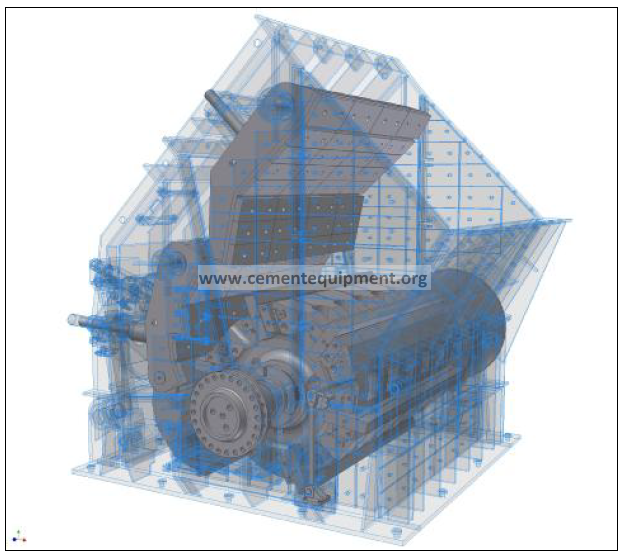
Introduction
The properties of raw materials required for the cement production differs at a wide
range. The limestone deposits used today as base material show very different properties
regarding hardness, abrasiveness and stickiness. To optimize the crushing and
at the same the investment and operating costs different types of crusher are available
on the market.
This paper should give a short overview how to optimize the crusher selection for the
cement industry.
Material Characteristics
Before choosing a crusher for a certain application the quarry and especially the
characteristics of the raw material has to be analyzed.
Of fundamental significance is the hardness of the material to be crushed. To describe
this property the compressive strength, the Los Angeles Index or the Mohs
Hardness should be determined.
In addition the abrasiveness of the material has to be described. This can be done by
determining the Silica content, the free quartz content and the abrasion index.
Of the same importance is to express the stickiness of the material. For this reason
the moisture, the clay content and in very difficult applications the handling coefficient
(shear test) has to be investigated.
Based on this values and characteristics of the material the overview on page 3 allows
to make a pre-choice of the required crusher.
Selection Criteria
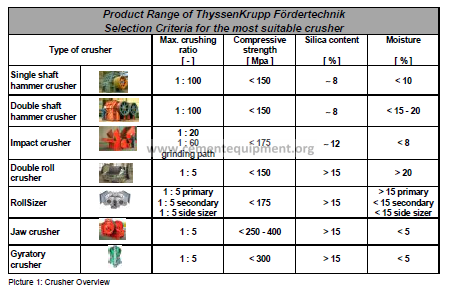
Primary crushing of limestone for the cement production requires high crushing ratios
to reduce the run of mine material in one step down to the required grain size distribution
(approx. 0 – 25/80mm) for the raw material mills. One step crushing should always
be the aim to keep on one side investment costs and on the other side maintenance
time and costs down.
According to the above overview one step crushing can be achieved by operating
hammer crushers and impact crushers. These crushers are fast running machines
with a high kinetic energy resulting in strong impact forces and high crushing ratios.
The allowable compressive strength of 150 Mpa is normally sufficient for most of the
limestone applications.
The silica content is an important issue to be considered when using hammer or impact
crushers. Due to the high speed of the rotors the crushing tools (hammers or
impact bars) are sensitive to wear. The limit for these machines is between 8%-12%
silica content. Before making a final decision the abrasiveness of the raw material has
to be analyzed very carefully to avoid suffering under high maintenance costs. If the
silica content is above the mentioned values a more ‘gentle’ crushing system with
lower crushing ratios in two steps has to be considered.
As final characteristics the moisture content has to be taken into account. While the
impact crusher is limited by a moisture content of max. 8% the double shaft hammer
crusher can still be operated up to a moisture content of up to 20%. This special feature
allows to charge limestone and sticky materials like e.g. clay at the same time to
obtain a pre-homogenization already in the crusher.
As soon as the silica or the moisture content is too high to operate one step crushing
systems with hammer or impact crushers two step crushing systems has to be installed
to reduce the run of mine material to the requested grain size distribution for
the raw material mills. Possible crushers for these two step systems are Double Roll
Crushers, RollSizers, Jaw Crushers and Gyratory Crushers which are all able to operate
in abrasive material. But while the crushing ratio of these crushers is approx. the
same (1:5) there ability to crush hard and/or wet material differs.
Jaw and gyratory crushers are crushing the material by high pressure and are suitable
for hard materials with a compressive strength of up to 400 Mpa. The compressive
strength of limestone is normally below 150 Mpa and these crushers are therefore
mainly used if the raw material is very abrasive. On the other side these machines
are sensitive to high moisture contents which have to be considered very carefully.
Double Roll Crushers and RollSizers are combining pressure and impact as well as
shear and tensile forces to crush the material. They are also limited regarding the
hardness of the material (max. 175 Mpa) but they can be operated in very sticky and
abrasive material.
The above made explanations about the different types of crushers show that for
every kind of limestone a suitable crusher combination exists to produce the required
grain size distribution. But not only for limestone also for the necessary additives (like
e.g. clay, lime, puzzolan, sandstone, iron ore, shist,….) with there different material
characteristics the proper crusher method can be optimized according to the material
properties.
Impact Crushers
With the introduction of vertical roller mills accepting a raw material size of up to
80mm the Impact Crusher became of significant importance for the cement industry.
Modern Impact Crusher are equipped with heavy duty rotors in common rail design.
Specially designed cast discs are combined on one main shaft concentrating the main
weight at the circumference of the rotor resulting in a high moment of inertia and kinetic
energy. This allows crushing run of mine material in one step down to the required
product size.
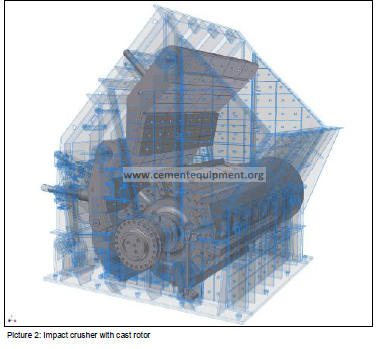
State of the art Impact Crushers are equipped with hydraulically supported impact
walls and grinding path allowing to adjust the crushing gap and the crushed product
size according to the requirements. Therefore one crusher can be sufficient to produce
limestone with a grain size of 0/80mm for the raw material mills and also limestone
with a grain size of 0/35mm as additive for the cement mills.
Due to the problem of having uncrushable material like e.g. tramp iron in the feed material
each impact crusher should be equipped with an effective overload protection.
ThyssenKrupp achieved this by combining the grinding path and the lower impact wall
as shown in picture #4.
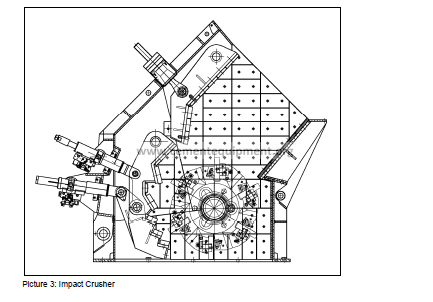
As soon as an overload occurs at the lower grinding wall the cylinders supporting the
impact wall and the grinding path are released. This allows the grinding path to avoid
any damages by opening the gap before the tramp iron passes the grinding path. After
discharging the uncrushable material to the discharge conveyor the hydraulic cylinders
push back the impact wall and the grinding path in its former position.
Maintenance friendly design like interchangeable wear plates, quick release bolts to
open very fast the housing, hydraulically fixed blow bars, blow bar lifting and rotor positioning
device are also standards for modern impact crushers
Double Shaft Hammer Crushers
The main crushing process by a Double Shaft Hammer Crusher is performed by the
rotating hammers between the rotor and above the anvil. It is important to understand
that the material is not ‘grinded’ on the grate baskets. The function of the grate baskets
is to calibrate the material. This allows by installing grate baskets with different
openings to produce either raw material for ball mills (0/80mm) or vertical mills
(0/25mm).
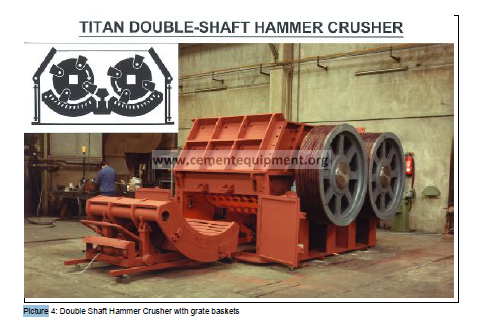
Double Shaft Hammer Crushers are used in the cement industry to solve crushing
problems in difficult materials like wet limestone combined with clay. This capability to
operate under such severe conditions without clogging problems is achieved by the
self-cleaning effect of this machine. The material is mainly in contact with rotating
element. Only the grate basket to calibrate the final grain size is fixed but cleaned by
the rotating hammers. Of course the entire crushing chamber geometry, the design of
the anvil and the grate baskets have to be optimized and adapted to avoid clogging
problems.
Picture 6 on the next page illustrates again the advantages regarding the nonclogging
effect of the Double Shaft Hammer Crusher. Impact crushers and single
shaft hammer crusher crush the material by impact of the hammers or the blow bars and by throwing the material against fixed impact or side walls which are not cleaned.
The Double Shaft hammer works like a Double Roll Crusher where the material is
only in contact with moving self-cleaning crushing tolls.
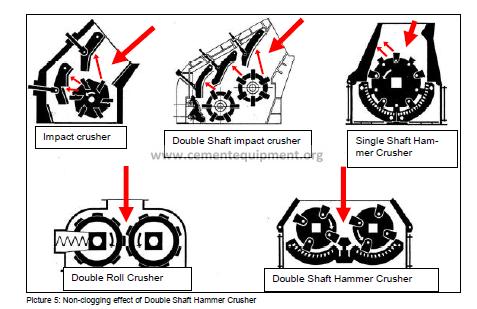
The feature to crush sticky materials allows feeding several materials by two or three
apron feeders simultaneously to the crusher resulting in a pre-homogenization already
in the crusher.
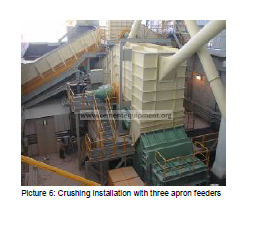
Double Roll Crusher and RollSizer
Although the Double Roll Crusher and the RollSizer have a low crushing ratio they are
also used in the Cement and lime Industry.
Compared to the speed of the rotors of the impact and hammer crushers the roll
crushers operate at low speed resulting in a product with minimized fines content.
This circumstance makes these machines especially suitable for the lime production
where a maximum of stones for the kiln is required.
But also under difficult conditions like extreme sticky (clay) or abrasive (clinker) materials
this type of machines is due to their operating speeds and non-clogging effect
the perfect solution.
Because limestone is mainly not very abrasive or extremely sticky it can be crushed in
one step and the Double Roll Crusher and the RollSizer are rarely installed as primary
limestone crusher. But regarding processing of additives they are of importance to
achieve an economical crushing solution.
Jaw crusher and Gyratory Crusher
Jaw crushers and Gyratory Crushers are mainly used for hard rock applications. They
can be applied for very abrasive materials with a compressive strength of up to 400
Mpa under the pre-condition that the material is not sticky or wet. There crushing ratio
is compared to the Impact and Hammer crushers low resulting in two step crushing
systems for primary limestone applications. Therefore they are also rarely used for
the main material production for the raw mills. Like the Roll Crushers these machines
can be used for minimizing the fines content and maximizing the stone content in the
crushed product for the lime production. Also additives like e.g. iron ore can be processed
with these machines.
Conclusions
Although the properties of the materials required for the cement production differs at a
wide span regarding hardness, abrasiveness and stickiness a sophisticated range of
crusher and crushing system is available. This allows to optimize each crushing process
and to minimize investment and operating costs.